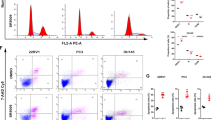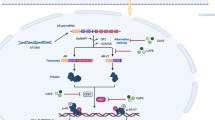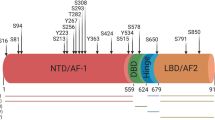Abstract
The synthetic retinoid 6-[3-(1-adamantyl)-4-hydroxyphenyl]-2-naphthalene carboxylic acid (CD437) induces apoptosis in several types of cancer cell. CD437 inhibited the growth of both androgen-dependent and -independent human prostate carcinoma (HPC) cells in a concentration-dependent manner by rapid induction of apoptosis. CD437 was more effective in killing androgen-independent HPC cells such as DU145 and PC-3 than the androgen-dependent LNCaP cells. The caspase inhibitors Z-VAD-FMK and Z-DEVD-FMK blocked apoptosis induced by CD437 in DU145 and LNCaP cells, in which increased caspase-3 activity and PARP cleavage were observed, but not in PC-3 cells, in which CD437 did not induce caspase-3 activation and PARP cleavage. Thus, CD437 can induce either caspase-dependent or caspase-independent apoptosis in HPC cells. CD437 increased the expression of c-Myc, c-Jun, c-Fos, and death receptors DR4, DR5 and Fas. CD437's potency in apoptosis induction in the different cell lines was correlated with its effects on the expression of oncogenes and death receptors, thus implicating these genes in CD437-induced apoptosis in HPC cells. However, the importance and contribution of each of these genes in different HPC cell lines may vary. Because CD437 induced the expression of DR4, DR5 and Fas, we examined the effects of combining CD437 and tumor necrosis factor (TNF)-related apoptosis-inducing ligand (TRAIL) and Fas ligand, respectively, in HPC cells. We found synergistic induction of apoptosis, highlighting the importance of the modulation of these death receptors in CD437-induced apoptosis in HPC cells. This result also suggests a potential strategy of using CD437 with TRAIL for treatment of HPC.
This is a preview of subscription content, access via your institution
Access options
Subscribe to this journal
Receive 50 print issues and online access
$259.00 per year
only $5.18 per issue
Buy this article
- Purchase on Springer Link
- Instant access to full article PDF
Prices may be subject to local taxes which are calculated during checkout







Similar content being viewed by others
References
Adachi H, Adams A, Hughes FM, Zhang J, Cidlowski JA and Jetten AM. . 1998a Cell. Death Differ. 5: 973–983.
Adachi H, Preston G, Harvat B, Dawson MI and Jetten A. . 1998b Am. J. Respir. Cell. Mol. 18: 823–333.
Adams JM and Cory S. . 1998 Science 281: 1322–1326.
Asada M, Yamada T, Ichijo H, Delia D, Miyazono K, Fukumuro K and Mizutani S. . 1999 EMBO J. 18: 1223–1234.
Ashkenazi A and Dixit VM. . 1998 Science 281: 1305–1308.
Ashkenazi A, Pai RC, Fong S, Leung S, Lawrence DA, Marsters SA, Blackie C, Chang L, McMurtrey AE, Hebert A, DeForge L, Koumenis IL, Lewis D, Harris L, Bussiere J, Koeppen H, Shahrokh Z and Schwall RH. . 1999 J. Clin. Invest. 104: 155–162.
Burns TF and El-Deiry WS. . 1999 J. Cell. Physiol. 181: 231–239.
Carroll AG, Voller H, Sugars L and Gelmann EP. . 1993 The Prostate 23: 123–134.
Chai F, Evdokiou A, Young GP and Zalewski PD. . 2000 Carcinogenesis 21: 7–14.
Chambon P. . 1996 FASEB J. 10: 940–954.
Deveraux QL, Leo E, Stennicke HR, Welsh K, Salvesen GS and Reed JC. . 1999 EMBO J. 18: 5242–5251.
El-Deiry WS, Takashi T, Velculescu VE, Levy DB, Parsons R, Trent JM, Lin D, Mercer WE, Kinzler KW and Vogelstein B. . 1993 Cell 75: 817–825.
El-Deiry WS, Harper JW, O'Connor PM, Velculescu VE, Canman CE, Jackman J, Pietnpol JA, Burrell M, Hill DE, Wang Y, Wiman GG, Mercer WE, Kastan MB, Kohn KW, Elledge SJ, Kinzler KW and Vogelstein B. . 1994 Cancer Res. 54: 1169–1174.
Fontana JA, Dawson MI, Leid M, Rishi AK, Zhang Y, Hsu CA, Lu JS, Peterson VJ, Jong L, Hobbs P, Chao WR, Shroot B and Reichert U. . 2000 Identification of a unique binding protein specific for a novel retinoid inducing cellular apoptosis. Int. J. Cancer. 86: 474–479.
Gazitt Y. . 1999 Leukemia 13: 1817–1824.
Gervais JL, Seth P and Zhang H. . 1998 J. Biol. Chem. 273: 19207–19212.
Gorospe M, Cirielli C, Wang X, Seth P, Capogrossi MC and Holbrook NJ. . 1997 Oncogene 14: 929–935.
Gorospe M, Martindale JL, Sheikh MS, Fornace Jr AJ and Holbrook NJ. . 1996a Mol. Cell. Differ. 4: 47–65.
Gorospe M, Wang X, Guyton KZ and Holbrook NJ. . 1996b Mol. Cell. Biol. 16: 6654–6660.
Greenlee RT, Murray T, Bolden S and Wingo PA. . 2000 CA Cancer J. Clin. 50: 7–33.
Harris DR and Savill J. . 1995 Br. J. Urology. 75: (Suppl. 1) 27–33.
Hsu CA, Rishi AK, Li X-S, Gerald TM, Dawson MI, Schiffer C, Reichert U, Shroot B, Poirer GC and Fontana JA. . 1997 Blood 89: 4470–4479.
Isaacs JT, Furuya Y and Berges R. . 1994 Semin. Cancer. Biol. 5: 391–400.
Isaacs WB, Carter BS and Ewing CM. . 1991 Cancer. Res. 51: 4716–4720.
Lee JM and Bernstein A. . 1993 Proc. Natl. Acad. Sci. USA. 90: 5742–5746.
Levkau B, Koyama H, Raines EW, Clurman BE, Herren B, Orth K, Roberts JM and Ross R. . 1998 Mol. Cell. 1: 553–563.
Li R, Waga S, Hannon GJ, Beach D and Stillman B. . 1994 Nature 371: 534–537.
Li Y, Lin B, Agadir A, Liu R, Dawson MI, Reed JC, Fontana JA, Bost F, Hobbs PD, Zheng Y, Chen G-Q, Shroot B, Mercola D and Zhang X-K. . 1998 Mol. Cell. Biol. 18: 4719–4731.
Liang JY, Fontana JA, Rao JN, Ordonez JV, Dawson MI, Shroot B, Wilber JF and Feng P. . 1999 The Prostate 38: 228–236.
Lotan R. . 1995 J. Natl. Cancer Inst. 87: 1655–1657.
Lowe SW, Reuley HE, Jacks T and Housman DE. . 1993 Cell. 74: 957–967.
Lu XP, Fanjul A, Picard N, Shroot B and Pfahl M. . 1999 Int. J. Cancer 80: 272–278.
Miyashita T, Krajewski S, Krajewska M, Wang HG, Lin H-K, Liebermann D, Hoffman B and Reed JC. . 1994 Oncogene 9: 1799–1805.
Mologni L, Ponzanelli I, Bresciani F, Sardiello G, Bergamaschi D, Gianni M, Reichert U, Rambaldi A, Terao M and Garattini E. . 1999 Blood 93: 1045–1061.
Muller M, Wilder S, Bannasch D, Israeli D, Lehlbach K, Li-Weber M, Friedmann SL, Galle PR, Stremmel W, Oren M and Krammer PH. . 1998 J. Exp. Med. 188: 2033–2045.
Packham G and Cleveland JL. . 1994 Mol. Cell. Biol. 14: 5741–5747.
Packham G and Cleveland J. . 1995 Biochem. Biophys. Acta. 1242: 11–28.
Piedrafita FJ and Pfahl M. . 1997 Mol. Cell. Biol. 17: 6348–6358.
Pitti RM, Marsters SA, Ruppert S, Donahue CJ, Moore A and Ashkenazi A. . 1996 J. Biol. Chem. 271: 12687–12690.
Polyak K, Waldman T, He TC, Kinzler KW and Vogelstein B. . 1996 Genes Dev. 10: 1945–1952.
Preston GA, Lyon TT, Yin Y, Lang JE, Solomon G, Annab L, Srinivasan DS, Alcorta DA and Barrett JC. . 1996 Mol. Cell. Biol. 16: 211–218.
Sawai H, Okazaki T, Yamamoto H, Okano H, Takeda Y, Tashima M, Sawada H, Okuma M, Umehara H and Domae N. . 1995 J. Biol. Chem. 270: 27326–27331.
Schadendorf D, Kern MA, Artuc M, Pahl HL, Rosenbach T, Fichtner I, Nurnberg W, Stuting S, Stebut EV, Worm M, Makki A, Jurgovsky K, Kolde G and Henz BM. . 1996 J. Cell. Biol. 135: 1889–1898.
Shao Z-M, Dawson MI, Li XS, Rishi AK, Sheiki MS, Han Q-X, Ordonez JV, Shoot B and Fontana JA. . 1995 Oncogene 11: 493–504.
Sheikh MS and Fornace Jr AJ. . 2000 J. Cell. Physiol. 182: 171–181.
Smeyne RJ, Vendrell M, Hayward M, Baker SJ, Miao GG, Schilling K, Robertson LM, Currant T and Morgan JI. . 1993 Nature 363: 166–169.
Sun S-Y, Yue P, Shroot B, Michel S, Dawson MI, Lamph WW, Heyman RA, Teng M, Chandraratna RAS, Shudo K, Hong WK and Lotan R. . 1997a Cancer Res. 57: 4931–4939.
Sun S-Y, Yue P, Shroot B, Hong WK and Lotan R. . 1997b J. Cell. Physiol. 173: 279–284.
Sun S-Y, Yue P, Shroot B, Hong WK and Lotan R. . 1999a Oncogene 18: 2357–2365.
Sun S-Y, Yue P and Lotan R. . 1999b Mol. Pharmacol. 55: 403–410.
Sun SY, Yue P, Wu GS, El-Deiry WS, Shroot B, Hong WK and Lotan R. . 1999c Cancer Res. 59: 2829–2833.
Thornberry NA and Lazebnik Y. . 1998 Science 281: 1312–1316.
Walczak H, Miller RE, Ariail K, Gliniak B, Griffith TS, Kubin M, Chin W, Jones J, Woodward A, Le T, Smith C, Smolak P, Goodwin RG, Rauch CT, Schuh JC and Lynch DH. . 1999 Nat. Med. 5: 157–163.
Wu GS, Burns TF, McDonald III ER, Jiang W, Meng R, Krantz ID, Kao G, Gan DD, Zhou JY, Muschel R, Hamilton SR, Spinner NB, Markowitz S, Wu G and El-Deiry WS. . 1997 Nat. Genet. 17: 141–143.
Zhang Y, Fujita N and Tsuruo T. . 1999 Oncogene 8: 1131–1138.
Acknowledgements
This study was supported by a grant from The Prostate Cancer Research Program, The University of Texas MD Anderson Cancer Center and by the Irving and Nadine Mansfield and Robert David Levitt Cancer Research Chair (R Lotan). We are thankful to Drs B Shroot and W Bollag for providing us with the retinoids. We are also grateful to Drs WS El-Deiry and P Chiao for providing us with some cDNA plasmids.
Author information
Authors and Affiliations
Rights and permissions
About this article
Cite this article
Sun, SY., Yue, P. & Lotan, R. Implication of multiple mechanisms in apoptosis induced by the synthetic retinoid CD437 in human prostate carcinoma cells. Oncogene 19, 4513–4522 (2000). https://doi.org/10.1038/sj.onc.1203810
Received:
Revised:
Accepted:
Published:
Issue Date:
DOI: https://doi.org/10.1038/sj.onc.1203810
Keywords
This article is cited by
-
Parallel screening of FDA-approved antineoplastic drugs for identifying sensitizers of TRAIL-induced apoptosis in cancer cells
BMC Cancer (2011)
-
Chemopreventive agent-induced modulation of death receptors
Apoptosis (2005)
-
Sensitization of prostate carcinoma cells to Apo2L/TRAIL by a Bcl-2 family protein inhibitor
Apoptosis (2005)
-
An antagonist of retinoic acid receptors more effectively inhibits growth of human prostate cancer cells than normal prostate epithelium
British Journal of Cancer (2004)
-
Apoptosis signaling by the novel compound 3-Cl-AHPC involves increased EGFR proteolysis and accompanying decreased phosphatidylinositol 3-kinase and AKT kinase activities
Oncogene (2004)



